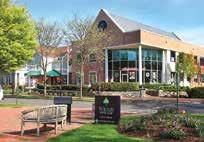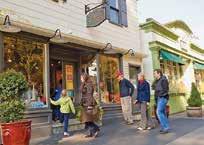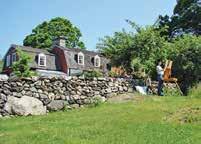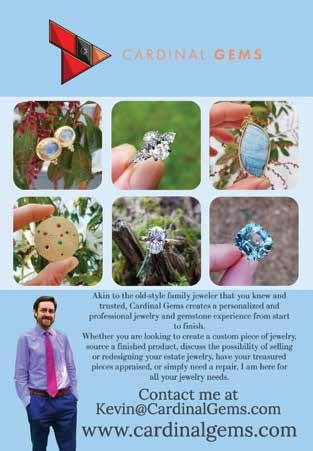
5 minute read
Neighborhoods: Wilton
Wilton Neighborhoods
[ EACH COMMUNITY ADDS TO OUR OVERALL PERSONALITY ]

Wilton Center
»Whether shopping, heading out to a restaurant, or attending a community-wide celebration, Wilton Town Center is welcoming to residents and visitors alike. One can buy groceries or wine, checkout an array of retail shops, go to a movie, or find a cozy spot to meet friends for coffee. Schenck’s Island offers multiple trails with cleared areas for fishing, picnicking or relaxing by the edge of the Norwalk River, and an escape to nature for dog walkers. The Wilton Library is a town treasure, with a full calendar of author talks, documentary film screenings, lectures, musical events, and programs for the whole family. There's the annual Mother's Day Plant sale in May, a July sidewalk sale, Halloweekend in October, the December Holiday Stroll, and the Winter Carnival held in January. Twice a year, local Wilton Center restaurateurs offer special menus during Restaurant Week.
Cannondale
»Originally called Pimpewaug by the local Native Americans, Cannondale was named after the Cannon family who became prominent in the area following the opening of their general store in the 1790s. The addition of the railway station came next, followed by a campaign by the Cannon family to open a neighborhood post office. Cannon Station was soon abuzz with activity. Today, the Metro-North Danbury branch continues to make stops at the Cannondale Station, but the area is better known for its small shops and businesses adjacent to the station, including The Schoolhouse at Cannondale restaurant. Diners there enjoy their meals in what was the second schoolhouse built in the neighborhood in 1872.
Silvermine
»The Silvermine section of Wilton has been known as an artist community since the early 1900s. A visionary sculptor named Solon Borglum moved to the area in 1906 and contributed to the artist movement there. Solon’s depictions of frontier life, especially sculptures based on his experience with cowboys and native Americans established his reputation. His was a subtler artistic path than his brother Gutzon and nephew Lincoln, who sculpted Mount Rushmore. Today the arts are still very much alive in the area thanks to the Silvermine
Wilton's neighborhoods provide endless access for walkers, runners, skiers, naturalists, fishing enthusiasts, and more.
Arts Center whose revolving exhibits, lectures, performances, and classes offer something for everyone. The 200-yearold Silvermine Tavern has now been fully renovated and is the sophisticated inn GrayBarns on the Silvermine River along with the popular restaurant, Tavern at GrayBarns.

Georgetown
»Encompassing parts of Wilton, Redding, Ridgefield, and Weston, Georgetown is a community unto itself. Its history revolves predominantly around the Gilbert & Bennett wire mill, which had its beginnings in the early 1800s. By mid-century, G&B, as it was known, had four locations and was home to the country's first machine for making wire netting and fencing. The foundation of one of the buildings can still be seen from Old Mill Road. Today, Georgetown’s manufacturing roots have been replaced by more than half a dozen restaurants, shops, the Georgetown Farmers Market, Caraluzzi's Market for groceries, and other businesses which make it easy for residents to meet their needs without traveling south to Wilton Center.
Middlebrook Farms
»Almost every Wilton resident spends a significant amount of time in the Middlebrook Farms section of town during the school year. Cider Mill Elementary School and Middlebrook Middle School are located on School Road and Wilton high school lies on the other side of the athletic field and public tennis courts. The recently renovated Comstock Community Center, which houses the Wilton Senior Center, the Parks and Recreation department, and Wilton Social Services is also situated along this stretch. There is free parking and access for walkers, runners, dogs on leashes, naturalists, and fishing enthusiasts, to the scenic wooded route down to Merwin Meadows. Beyond the school district are residential neighborhoods made up of both historical and newer homes.
North Wilton
»Take a trip through North Wilton on July 4 and you'll see why this rural part of town has the community feel of days gone by. The Nod Hill Fourth of July Parade travels for less than a mile but draws crowds each year who cheer for elaborate floats made by their neighbors and friends, then gather for an old-fashioned picnic, complete with sack races. North Wilton is also home to the Weir Farm National Historic Site, which was featured in Ken Burns’ documentary series The National Parks: America’s Best Idea. It is the only National Park Service site dedicated to American painting and was the home (and inspiration) for artists Julian Alden Wier, Mahonri Young, and Sperry Andrews. An indoor and outdoor attraction, it offers spring through fall indoor tours of the on-site house and studios, yearround hiking trails, and specialized spring through fall programs. For true outdoor enthusiasts, the Wilton Town Forest, with entrances off Boas and Branch Brook Roads, offers 192 acres of natural beauty, many hiking trails, streams, and even a picturesque waterfall.


South Wilton
»Bordering Norwalk, South Wilton is a commercial hub frequented by those working in the area’s many office complexes, or shoppers seeking larger retailers like Outdoor Sports Center. Despite the hustle and bustle of Route 7, there is natural beauty to be found here as well. Cranbury Park and Gallaher Mansion is a breathtaking space featuring 227 wooded and open acres frequented by hikers, dog walkers, and those looking to play disc golf on its 18-hole course. The course is laid out over acres of lush New England woodland. The Gallaher Estate Tudor revival mansion is a stunning snapshot of history, built in 1930 and meticulously maintained as a modern event venue. Whether working, shopping, hiking, dining at a wide variety of cuisines from Asian to Italian—South Wilton has much



